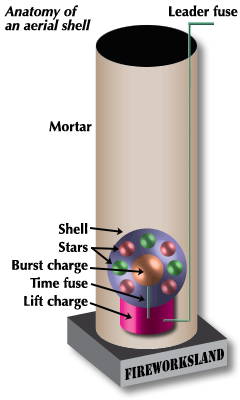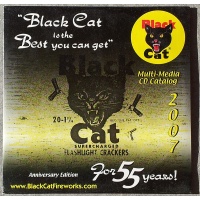Fireworks are hand-crafted devices made of chemicals and paper, which produce visual and audible effects for entertainment purposes. What you see and hear are the result of chemical reactions that take place when the firework is ignited. For example, when you see an aerial shell firework burst open into hundreds of pinpoints of colored light, each of those pinpoints is the result of a pellet of chemicals (called “stars”) undergoing a reaction that produces colored light.
A sound effect, such as a loud boom, shrieking whistle, cluster of crackle, or even buzzing sounds, are also the results of chemical reactions and the way devices are made. Color smoke effects that you see in daytime fireworks are created by using powdered dyes in the chemical mixes. Motion effects such as spinning or flying are caused by using some tubes as thrust devices.
 The chemicals are carefully packed into the devices (which are almost always paper tubes or containers) by hand; fireworks is still very much a labor-intensive craft and very little of it is automated, although paper tubes are often machine-made and labels of course printed on printing presses. But the actual manufacture and assembly of devices is still done primarily by hand and most manufacturing is done in China. Then they are dried, packed, warehoused, exported, shipped across the ocean, imported, distributed, wholesaled, retailed, bought, stored, set up and used.
The chemicals are carefully packed into the devices (which are almost always paper tubes or containers) by hand; fireworks is still very much a labor-intensive craft and very little of it is automated, although paper tubes are often machine-made and labels of course printed on printing presses. But the actual manufacture and assembly of devices is still done primarily by hand and most manufacturing is done in China. Then they are dried, packed, warehoused, exported, shipped across the ocean, imported, distributed, wholesaled, retailed, bought, stored, set up and used.
When the firework is finally ignited at the location of the show, the fire or spark used to ignite it travels through the firework’s exterior fuse to the inside of the device. It sets off the chemical reactions that result in the visual and audible effects. In the case of a ground-based fountain, it ignites the top of a tube that contains mixtures of chemicals, and as the chemicals burn they are expelled from the top of the tube in a spray or shower. Other devices operate differently, depending on the intended result.
In the case of a sparkler that you hold in your hand, the chemicals are not contained but are simply a coating on a stick, and burn giving off the intended effects. In the case of a firecracker, the explosive powder in the tube ignites and blows apart the cracker with an audible bang. In the case of a spinning firework, the spinning motion is caused either by a carefully tube giving off thrust or a tube that has a hole punched in one end. If wings are attached to the spinner then it’s a flying spinner or helicopter and flies up off the ground as it spins.
In the case of a skyrocket, the “engine” part gives off an initial thrust to get the rocket flying, the stick helps stabilize the flight, and the “payload” part eventually ignites the effects intended. In the case of an aerial shell, the long “leader” fuse ignites a “lift charge” in the bottom of the shell, which propels the shell out of the mortar (tube) much like a gun. The lift charge also ignites a short, internal “time fuse” inside the shell which burns until the shell reaches the apex of its flight, at which time the time fuse ignites a second explosive charge in the center of the shell. This second charge is the “burst charge,” which causes the shell to burst open in the air and also ignites the effects, usually the stars, or whatever effects were packed into the shell.
Sometimes you see a trail of color or sparks flying up from the ground, either by itself or ending in an aerial burst of stars. The trail is called a comet or tail, and is produced by a secondary device attached to the shell (sometimes glued right onto it) which gives off the sparks as the whole thing flies up. Sometimes you see a picture or word made up of many colored flames; this is called a “set piece” and is created by attaching small color flares called “lances” to a wooden framework, in a pre-designed pattern to produce a recognizable word or image. They are connected by “quickmatch” which is an extremely fast-burning type of fuse, so that all the lances start burning at virtually the same time.
There are about 30 general types of fireworks (see the Types article) and roughly 90 different effects (see the Effects article) with up to 20 different colors available, so the possible variations for just one firework number in the thousands. And indeed there are thousands and thousands of fireworks on the market. On top of that, there are different ways of arranging firework effects, within a single device and overall within a show and its setup, timing and choreography. So the possibilities are pretty much limitless depending on what fireworks are available for the show and what the show’s designer wants to do with them.
Besides the types, there are also various legal classifications for fireworks. Usually they are classified by their dimensions and pyrotechnic content but also sometimes by what chemicals are used. Different countries, states, counties, cities and townships can have their own laws and classifications as to exactly what is legal in that jurisdiction. In the United States there are 2 general classifications that cover most fireworks, Display and Consumer. For a more detailed discussion see the Classifications article.
If you are interested in getting into the world of fireworks displays and shows, the best way to get started is to find a fireworks display producer in your area, contact them and try to get on the crews of shows. Try looking in your Yellow Pages under "Fireworks" or just do an online search. Contact them and ask them how to get onto crews. The more experience you have in working on shows the better. You can study pyrotechnics and the state laws in your area, and eventually get a state pyrotechnic operator’s license, if you want to put on your own shows.







